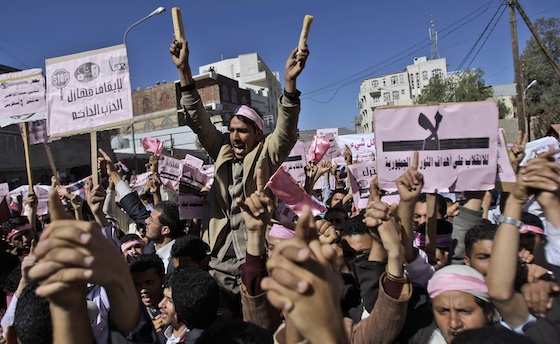The videos below show the current size and emotion of some of the protests.
January 27, 2011
February 14, 2011
February 15, 2011
February 15, 2011 in Taiz
What Al Jazeera keeps calling “huge concessions” given by president Saleh that he would not run again in 2013, may actually have just been an agreement already reached between Saleh and the US as indicated by a US state cable. They are, in any case, simply a repeat of promises made and broken in 2006 when instead of resigning he asked for an amendment to the constitution to allow him to be appointed for life. None of the "concessions" seem to be placating the protestors. The US, which contributed over $150 million in military aid to Yemen in 2010, announced yesterday, during the fourth day of vicious attacks on demonstrators by Saleh’s security forces, that they would be spending US$75 million to double the size of a “special Yemeni counter-terrorism unit”. This is in addition to US$120 million for Yemen in Obama's 2012 budget request on Monday. In 2006, the US gave only US$5 million to Yemen and in 2009, US$67 million. The special relationship between Saleh and the US as depicted in the US state cables has been explored on WL Central here, here and here. Journalist Abdul Ilah Shayi who revealed the US military attack that killed 55 civilians is also discussed along with Obama’s interference in his release.
Cold War roots of Yemen conflict

The roots of Yemen's current civil conflict, in which the government is trying to put down a localised but potent rebellion, lie in the Cold War regional politics of the 1960s.
Then, Egyptian-backed army officers brought an end to Yemen's 1,000-year Shia Imamate and established the modern Yemeni republic.
Republican troops seized control of Yemen's capital, Sanaa, in 1962, while the imam fled to the northern mountains, where he mounted a spirited counter-offensive from the same territory where the fighting is happening today.
Then, as now, a well-equipped army in Sanaa deployed air power and superior military hardware against the rebels in the Saada region but for five years republican forces failed to defeat the mountain guerrillas.
Then, as now, regional dynamics inflamed local tensions inside Yemen, with Saudi Arabia and Jordan backing Yemen's imam against thousands of Egyptian troops barracked in Sanaa.
War 'over'
The 21st Century geopolitical context has undeniably changed, but regional tensions continue to stoke the conflict in Yemen.
 President Saleh declared the war "over" in 2008 |
Shia Iran stands accused of supporting the Saada rebels, despite the fact that Yemen's Zaydi Shias - who take their name from the fifth imam, Zayd Ibn Ali - are doctrinally distinct from Iran's Twelver Shias.
At times, the insurgents in Saada have also been accused of accepting support from Libya, Hezbollah and al-Qaeda, as well as Yemen's local Jewish minority.
Such inconsistent allegations are certainly exploited for shifting and expedient political reasons.
Perceptions of external interference in Yemen serve to distract attention from multiple internal factors driving this brutal stop-start war, which began in 2004 when the rebels condemned Yemen's government for allying with the West on counter-terrorism and called for freedom to worship according to their own traditions.
Yemen's government has since brokered several failed ceasefire agreements with the rebels, and in July 2008 President Ali Abdullah Saleh abruptly declared the Saada war "over" during celebrations for his 30th anniversary in power.
Religious balance
However, the underlying grievances have not been resolved and resentments keep escalating during each cycle of conflict, drawing local tribes into the fight.
 The UN says Yemen's "humanitarian emergency" has been overlooked |
Yemen's ruling imams historically derived their legitimacy partly from their sayyid status and the charismatic Houthi family who now lead the Saada rebellion are also sayyid - although, the Houthis deny allegations that they intend to reinstate the imam's rule.
While there is a sectarian element to this war, it lies in the delicate local religious balance between Zaydi Shia and Sunni Salafi teaching institutes in the Saada region.
The rebels accuse President Saleh of playing divide-and-rule politics by promoting Sunni Salafi institutes while restricting the activities of a Zaydi Shia revivalist movement, known as the Believing Youth.
However, many contributing factors to the Saada war are much more profane.
A recent report from the International Crisis Group (ICG) noted that the "conflict has become self-perpetuating, giving rise to a war economy".
Looting, drug smuggling, gunrunning, people trafficking, tribal feuds and an unresolved hostage crisis, involving a kidnapped Briton, have also contributed to the lawless reputation of the Saada region.
Resources strained
The United Nations' Office for the Coordination of Humanitarian Affairs (Ocha) claims Yemen's "humanitarian emergency" has been "largely neglected" by the international community and a $23m (£14m) flash appeal to help 150,000 internally displaced people fleeing the fighting in Saada has not yet received any funds.
 |
In addition to the war in Saada, the government confronts a southern separatist movement and resurgent terrorist networks.
Increasing numbers of Somali refugees and a rapidly growing domestic population place escalating strain on Yemen's fragile resources.
The fear that Yemen could eventually fragment now preoccupies Yemen's neighbours and its Western allies.
The scenario of state collapse in Yemen would create even greater potential for external interference in this strategic Arabian Peninsula state.
by Ginny Hill the author of Yemen: Fear of Failure and a Yemen analyst









No comments:
Post a Comment
coment